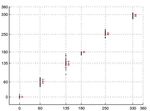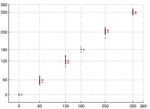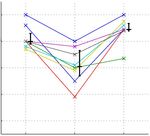The Binaural Sky: A Virtual Headphone for Binaural Room Synthesis
←
→
Page content transcription
If your browser does not render page correctly, please read the page content below
The Binaural Sky: A Virtual Headphone for Binaural Room
Synthesis
Daniel Menzel1,2 , Helmut Wittek3,1 , Günther Theile1 , and Hugo Fastl2
1
Institut für Rundfunktechnik, München
2
AG Technische Akustik, MMK, Technische Universität München
3
Schalltechnik Dr.-Ing. Schoeps GmbH (since 2005)
listener’s head. As a result, the virtual sources are
perceived at their real distance and their location
A novel system for the reproduction of vir- stays constant regardless of the head direction of
tual acoustics is presented in theory and prac- the listener.
tice. The system combines wave field synthe- However, a drawback of the BRS system is the
sis, binaural techniques and transaural au- need to wear headphones. If it is not possible
dio. Stable localisation of virtual sources to wear headphones, e.g. in a car or in a situ-
is achieved for listeners that are allowed to
ation where real and virtual sources have to be
turn around and rotate their heads. Focused
sources are used for transaural signal repro-
mixed (“augmented reality”), a binaural reproduc-
duction. The position of the focused sources tion without headphones would be desirable.
is kept constant relative to the ears of the
listener for every head direction by means of
a head tracking system. Therefore, there is
Concept
no need to change the crosstalk cancellation
The standard way to play binaural signals via loud-
filters during head rotations, so that audible
artefacts and instabilities are avoided. The speakers is to use transaural stereo, which uses
system is sufficiently stable allowing for loud- crosstalk cancellation (XTC) filters to eliminate the
speaker installations even above the listener. unwanted signal paths between the speakers and
As a result, binaural (e.g. BRS) reproduction the ears [1][2]. To obtain the XTC filters, the head
can be enjoyed without wearing a headphone related transfer functions (HRTF) of the path be-
and without any loudspeakers in the listener’s tween the loudspeakers and the ears of the listener
field of vision. have to be measured or calculated with a mathe-
matical model (e.g. [3]). However, the need for
Motivation head-tracking results in the use of a whole set of
XTC filters which have to be updated with every
Binaural Room Synthesis (BRS), a technique devel- head rotation. This can result in audible artefacts.
oped at the IRT in the early 90s, provides a virtual In the best case, the loudspeakers used to repro-
listening environment via headphones. A primary duce the transaural signal ought to move with the
example where BRS can be used is to aid sound en- head rotation of the listener, so that the relative po-
gineers in sonically difficult situations, like OB-vans sitions between the sound sources and the ears stay
[5]. The signal to be reproduced is convolved with constant and only one set of cancellation filters is
measured binaural room impulse responses (BRIR) needed. This is shown in figure 1.
and played back via high quality diffuse field equal- Of course this concept isn’t feasible with normal
ized headphones. For every virtual source that is to loudspeakers. Therefore, in the Binaural Sky the
be synthesized, a real loudspeaker has to be mea- speakers are replaced by focused sources produced
sured using a dummy head. The dummy head is with techniques known from wave field synthesis
put on a rotation table, so that the BRIR of ev- (WFS). These focused sources act as the transaural
ery head direction can be stored. To avoid front- loudspeakers, but they can easily be moved around
back inversions and to achieve a stable localisation by adjusting the driving functions (i.e. the delay
of the virtual sources, a head tracker is used dur- times and attenuations) of the array loudspeakers.
ing playback which dynamically changes the set of By synthesizing focused sources at a close dis-
BRIR corresponding to the current azimuth of the tance to the listener’s head and using these as the
1puter displays or TV monitors.
Signal Processing
All real time processing is done on a standard Linux
PC with a 24 channel RME Hammerfall sound
Figure 1: If the speakers of a transaural system card. BruteFIR is used as the central processing en-
move with the head rotation, only one set of XTC gine, as it provides the necessary capabilities with
filters is needed because the HRTFs stay constant. its high throughput partitioned convolution algo-
rithms. Figure 4 shows the signal path used for
real time processing.
The Nch input signals (e.g. Nch = 5 for 5.1 sur-
round playback) are fed into a first instance of the
BruteFIR software. This module is responsible for
performing the BRS related convolutions resulting
in a binaural signal. The BRIR are changed accord-
ing to the azimuth delivered by the head-tracker,
so that at any time the correct BRIR is active and
used for convolution. The binaural signal could al-
ready be played over headphones at this point, but
the goal of the Binaural Sky is loudspeaker repro-
duction, so another processing stage is necessary. A
second instance of BruteFIR convolves the binau-
Figure 2: The circular array synthesizes focused
sources which act as transaural sources.
ral signal with pre-calculated filters and distributes
it to the 22 array loudspeakers and the low fre-
quency driver. This second stage acts as a “virtual
transaural loudspeakers, a stable reproduction can headphone” - and also other non-binaural signals
be achieved without the need for adaptive XTC may be reproduced through this stage. Using this
filters. The actual configuration of the focused stage only, the inherent properties of pure head-
sources (i.e. number and position) is flexible and phone listening can be simulated, e.g. “In-Head-
can be changed as needed for an optimal transaural Localisation”.
performance. Significant practical work was done The pre-calculated filters consist of the crosstalk
at the IRT to optimise these parameters. cancellation filters combined with the wave field
driving functions. The XTC filters are obtained by
taking the matrix of HRTFs of the focused sources
The Loudspeaker Array A and computing its pseudo inverse A+ , as de-
scribed in [1] and [4]. The WFS filters can then be
Instead of a standard linear WFS array however, a
calculated from the array geometry and combined
circular design was chosen to ensure constant dis-
with the XTC filters. Note that only the wave field
tances between the ears, the focused sources, and
filters depend on the azimuth of the listener’s head
the array speakers. This leads to a constant alias-
- the transaural part is constant.
ing frequency and greatly reduces audible sound
colourations during head rotations. Figure 2 shows
a schematic view of the circular array with two fo- Objective Evaluation
cused sources (red and blue dots). The dashed cir-
cle indicates the path on which the focused sources The performance of the complete system was eval-
move during a full head rotation. uated using simulations and measurements. A cen-
The real array has a diameter of 1m and consists tral performance measure is the crosstalk attenua-
of 22 broadband speakers (Ø 8 cm) with a single tion, i.e. the level of a signal from the left binaural
low frequency driver (Ø 20 cm) in the middle to channel at the right ear and vice versa. In an ideal
reproduce frequencies below 120 Hz. The speakers XTC system, the direct path transfer functions (left
are mounted in a baffle without an enclosure. The channel to left ear and right channel to right ear)
whole setup is suspended above the listener at a dis- would be one, and the crosstalk transfer functions
tance of 40 cm from the head (see figure 3). Note would be zero. Figure 5 shows a simulation (left)
that there are no loudspeakers in the listener’s field and a measurement (right) of the crosstalk cancel-
of vision so as not to obstruct the view on e.g. com- lation performance at the right ear. The red curves
2Figure 3: Left: Measurement of the array with a dummy head. Right: The array in a typical listening
position in the IRT studio.
Figure 4: Real time signal processing necessary to produce the loudspeaker signals.
show that the direct path transfer functions are in- (in the right diagram) the direct path transfer func-
dependent of frequency up to about 7 kHz, from tion at the right ear is distorted, which results in se-
where on spatial aliasing starts to have a negative vere sound colourations and doesn’t allow the per-
influence on the XTC process. This can also be ception of virtual sources. Subjective tests showed
seen in the attenuation of the crosstalk, indicated that these effects are tolerable up to a displacement
by the blue curves, which stays at a level of about of about 8 to 10 cm.
-20 dB up to the aliasing frequency. To minimize the negative effects of the limited
At the moment, only head rotations are tracked sweet spot, the sound is switched off if the listener
and used for synthesis of virtual sources. Head moves away from the central point by more than
movements out of the central listening area un- 5 cm to the sides or 10 cm to the front or back.
der the array (the “sweet spot”) cause changes in Thereby it is assured that the listener only listens
the HRTF of the listener and therefore have neg- to a correct binaural signal.
ative effects on the success of the crosstalk can- In future applications it is well possible to in-
cellation. This can be seen in figure 6. The red clude head movements into the dynamic process as
curves show the measured transfer functions with well. This would lead to the need for delay time
the dummy head in the correct central position. adjustments of the driving functions.
The dummy head was then moved to the right in
steps of 2 cm, which is depicted by the grey curves: Subjective Evaluation
the lighter the colour, the greater the lateral dis-
placement. It is clearly visible in the left diagram The performance of the synthesized virtual sources
that the crosstalk attenuation decreases and that with respect to localisation and sound colouration
3Figure 5: Simulation and measurement of the XTC performance at the right ear at an azimuth of 0◦ .
Figure 6: Measured effects of lateral displacement of the head on the crosstalk cancellation performance.
Here, the dummy head was facing forward (azimuth of 0◦ , red curves), then moved to the right in steps of
2 cm up to 10 cm (gray curves).
was evaluated by psychoacoustical experiments.
Localization
Six real sound sources (small loudspeakers posi-
tioned around the subject) were compared to six
virtual sources, which were synthesized at the same
locations. All loudspeakers were hidden behind a
sonically transparent curtain. The azimuths of the
sources were 0◦ , 60◦ , 135◦ , 180◦ , 250◦ and 330◦ , the
elevations were 0◦ , +25◦ , -25◦ , 0◦ , +10◦ and -10◦ ,
at a distance of 1m (figure 7). 15 subjects partici-
pated in this experiment and marked the perceived
azimuth and elevation of the auditory events in a
template on a piece of paper. Pink noise bursts Figure 7: Setup of the localisation experiment
with a sound pressure level of 60 dB(A) were used with three of the six real sound sources visible.
The array is hidden above the horizontal curtain.
as a stimulus.
The horizontal localisation of virtual sources
achievable with the Binaural Sky is comparable to
real sound sources, which can be seen in figure 8. It can be seen that the real sources are recognized
All virtual sources are perceived with good accu- quite accurately, but with greater variations than in
racy and only small variations, very similar to real the case of azimuth perception. The virtual sources
sources and headphone reproduction [6]. show even more variation and a tendency of being
A correct perception of elevation seems to be perceived too high by about 10◦ . Virtual sources
more difficult to achieve, as figure 9 suggests. Here with negative elevation apparently cannot be syn-
the actual (green) and perceived (blue) elevations of thesized with meaningful results, as can be seen
the sources are plotted against the source number. from sources 3 and 6. These results however are
4Figure 8: Results of the localization experiment: azimuth perception of real and virtual sources. The black
dots show all answers given by the subjects, the median and interquartile range are drawn in red.
Figure 9: Results of the localization experiment: elevation perception of real and virtual sources. The
black dots show all answers given by the subjects, the median and interquartile range are drawn in red. The
green curve indicates the actual elevations, the blue curve shows the perceived elevations.
also known from headphone reproduction of binau-
ral signals [6].
Sound coloration
In another experiment, possible sound colouration
due to different source positions was investigated.
Four virtual sources in front of the subject had to
be compared regarding their differences in sound
colour, using a standard 5-grade ITU scale (rang-
ing from “very annoying” to “not perceptible”).
Figure 10: Variations in sound color between
Again, pink noise bursts were chosen as the stim-
four sources with different positions. The colored
ulus. Three reproduction methods were compared: curves show the results of the eight subjects, the
the Binaural Sky array, headphones and, as a ref- median and interquartile range is drawn in black.
erence, four individual loudspeakers of the circular
array. The results can be seen in figure 10.
The differences in case of the Binaural Sky where Conclusion
rated “perceptible, but not annoying”, just under
the rating for headphone reproduction. The results The Binaural Sky [7] can act as a virtual headphone
of the individual array loudspeakers suggest that for Binaural Room Synthesis, using wave field syn-
there are already considerable differences between thesis and transaural techniques. The usage of a
the small broadband speakers used in the array, so head-tracker allows for stable virtual sources and
that better drivers could further improve the whole avoids In-Head-Localisation. Psychoacoustical ex-
system. periments showed a very good horizontal localisa-
5tion of virtual sources, comparable to BRS play- ogy, PhD thesis, September 1997
back via headphones or even real sound sources.
However, there is no meaningful elevation percep- [4] Hokari, H. ; Furumi, Y. ; Shimada, S. : A
tion for virtual sources below ear level, and sources study on Loudspeaker Arrangement in Multi-
at or above ear level frequently are heard about Channel Transaural System for Sound Image
10 too high. Variations in sound colour between
◦ Localization. In: AES 19th Int. Conference on
different virtual sources are rather uncritical. Surround Sound, Elmau, 2001
[5] Horbach, U. ; Pellegrini, R. ; Felderhof,
References U. ; Theile, G. : Ein virtueller Surround Sound
Abhörraum im Ü-Wagen. In: 20. Tonmeisterta-
[1] Bauck, J. ; Cooper, D. H.: Generalized gung, Karlsruhe, 1998
Transaural Stereo and Applications. In: J. Au-
dio Eng. Soc. 44 (1996), September, Nr. 9, S. [6] Spikofski, G. ; Fruhmann, M. : Optimisation
683–705 of Binaural Room Scanning (BRS): Consider-
ing inter-individual HRTF-characteristics. In:
[2] Damaske, P. : Head related two channel AES 19th Int.Conference on Surround Sound,
stereophony with loudspeaker reproduction. In: Elmau, 2001
JASA 50 (1971), S. 1109–1115
[7] Wittek, H. .
[3] Gardner, W. G.: 3-D Audio Using Loud- http://www.hauptmikrofon.de/binauralsky.htm
speakers, Massachusetts Institute of Technol-
6You can also read


























































